GetResponse now also provides a website builder, chat features, e-commerce features, webinar hosting, landing pages, and automated sales funnels.
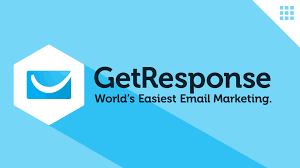
What is GetResponse
GetResponse is an email marketing app that allows you to:
- create a mailing list and capture data onto it
- send emails to the subscribers on your mailing list
- automate your email marketing using ‘autoresponders’
- view and analyze statistics related to your email campaigns – open rate, click-through, forwards etc.
GetResponse has shifted its emphasis considerably — the product now aims to be more of an ‘all-in-one’ e-commerce and online marketing solution, rather than a conventional email marketing tool.
Accordingly, in addition to email marketing features, GetResponse now also provides a website builder, chat features, e-commerce features, webinar hosting, landing pages, and automated sales funnels.
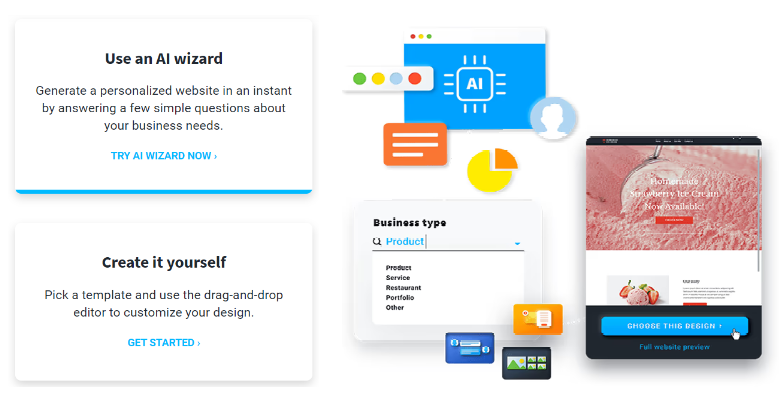
GetResponse has recently introduced new features that make it more of an ‘all in one marketing platform.
GetResponse pricing
- Getresponse Free — this is $0 and lets you use a cut-down version of Getresponse indefinitely, so long as your list remains under 500 subscribers.
- Basic — starting at $10 – $15 per month to send an unlimited number of emails to up to 1,000 subscribers
- Plus — starting at $49 per month for up to 1,000 subscribers
- Professional — starting at $99 per month for up to 1,000 subscribers
- Max — custom pricing.
As you add more subscribers to your list, the costs increase. At the top end of the scale, you can expect to pay $450, $499 or $580 per month to use GetResponse with a list containing 100,000 subscribers on the ‘Basic,’ ‘Plus’ and ‘Professional’ plans (respectively).
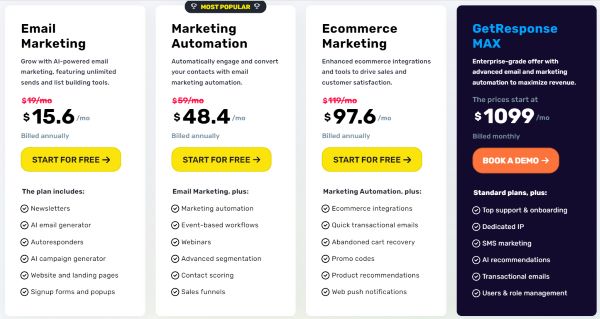
With regard to the ‘Max’ plan, exact pricing depends on requirements and list size if you’re interested in it, you’ll need to contact GetResponse to schedule a demo, discuss your needs, and negotiate to price.
Decent discounts are available if you pay upfront for 1 or 2 years of service (18% and 30% respectively).
You can try the paid-for plans out for 30 days free, via a trial that you can access here.
The core features common to all paid-for GetResponse plans are as follows:
- the ability to import and host a subscriber list
- a range of e-newsletter templates
- autoresponder functionality
- landing pages
- sales/leads funnels
- Facebook and Google Ad management tools
- a website builder tool
There are a number of differences between the ‘Basic’, ‘Plus’ and ‘Professional’ plans, the key ones are below:
- Automation builder — arguably GetResponse’s standout feature, the automation builder (which allows you to build complex autoresponder sequences based on user behavior) is only available on the ‘Plus’ plan or higher.
- Conversion funnels — you get access to more automated sales funnels as you go up the pricing ladder.
- Live webinars — this functionality is not available at all on the ‘Basic’ plan and the number of webinar attendees is capped for the ‘Plus’, ‘Professional’, and ‘Max’ plans at 100, 300, and 1000 respectively.
- Team management — you can only have one user account on the ‘Basic’ plan; by contrast, you get 3 on ‘Plus’, 5 on ‘Professional’, and up to 500 on ‘Max.‘
- E-commerce — the abandoned order recovery feature (which automatically sends reminder emails to your site visitors who don’t complete an order) is only available on the ‘Plus’ plan or higher.
Key GetResponse features
By comparison with other email marketing tools, GetResponse comes with an unusually large feature set even on its entry-level plan.
The platform provides all the key stuff you’d expect from an email marketing platform list hosting, templates, autoresponders, analytics, and so on, but as mentioned above, it’s recently been expanding its feature set to the point where it has morphed into an all-in-one marketing and e-commerce solution.
The question is whether all this makes the product a jack of all trades and a master of none.
Let’s drill down into its features to find out.
Autoresponders
Autoresponders are e-newsletters that are sent to your subscribers at intervals of your choosing.
For example, you can set them up so that…
- immediately after somebody signs up to your contact list, they receive a welcome message from your business
- a week later they receive a discount offer for some of your products or services
- three weeks later they receive encouragement to follow you on social media.
GetResponse’s autoresponder functionality is a key selling point, the product provides some of the most comprehensive autoresponder functionality available.
You can use GetResponse autoresponders to send either time-based or action-based messages — time-based options include cycles such as the example above and action-based messages can be triggered by user actions or information, for example:
- opens
- clicks
- subscriptions to particular lists
- changes in contact preferences
- completed transactions/goals
- birthdays
- changes in user data
Marketing automation tools
In addition to the basic style autoresponders mentioned above, GetResponse provides a more sophisticated option for sequencing emails automatically.
This is called ‘Marketing Automation,’ and is only available on ‘Plus’ plans or higher.
The feature allows you to create automation workflows using a drag and drop editor — you basically set up an ‘automation flowchart’ that instructs GetResponse what to do if a user opens a particular offer, clicks on a certain link, etc.

GetResponse’s marketing automation tool — you can use a drag and drop editor to build extremely sophisticated user journeys.
The functionality on offer here goes far beyond what’s traditionally been available from autoresponders and allows you to create a user journey that can be customized to an enormous degree. Get Started Here
For a quick visual overview of how all this works, you can take a look at GetResponse’s video walkthrough of its marketing automation features, below.
Getresponse email templates
There are around 120 GetResponse templates available — less than some competing email marketing solutions (notably AWeber, which offers around 600) — but they are varied in nature and the designs are contemporary (and easily editable).
The email templates are grouped into a few categories focussed around core goals — promoting, educating, selling, etc. — and their quality is generally high.
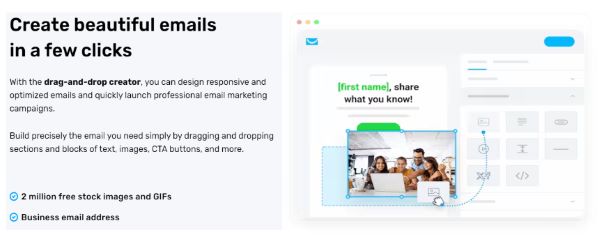
GetResponse email creator allows you to make extensive use of web fonts. A really wide selection of Google Fonts can be used in your e-newsletters — more than any competing tools.
This wide selection of web fonts is great, because — given the prevalence of Google fonts in corporate branding these days — it will let many users create email campaigns that maintain brand values.
It’s important to remember that not all email programs support the use of web fonts — you can specify a ‘fallback font’ in GetResponse to accommodate those — but in the ones that do, emails created via GetResponse have the potential to look very nice indeed.
Finally, the GetResponse templates are all responsive, meaning they adjust themselves automatically to suit the device that an e-newsletter is being viewed on — mobile, tablet, desktop computer, etc.
A preview function is available to see how your newsletter will appear on desktop and mobile.
(It would be nice if a tablet preview option was available too — although, in truth, most tablet devices display emails in a similar way to desktops).
GetResponse Analytics
GetResponse offers a good range of analytics and reporting options.
You get all the basics of course — open rate, click-through, unsubscribe rates, and so on in addition to that, there are some very nifty reporting features that are worth a particular mention, namely:
- ‘one-click retargeting‘: a way to easily identify people who engaged or didn’t engage with a particular newsletter, and send them an appropriate follow-up
- ‘email ROI‘: by adding some tracking code to your post-sales page on your site, you can find out how effectively (or not!) your email campaigns are driving sales, and work out your return on investment in email marketing.
- per-user information — you can click on one of your subscribers and see where they signed up from, where they’re located, and which emails they’ve opened in the past.
- e-newsletter performance comparison — you can compare the performance of two e-newsletters side-by-side really easily.
Mailchimp and AWeber offer some similar reporting functionality — particularly where sales tracking is concerned— but GetResponse’s reporting tool is one of the more fully featured out there.
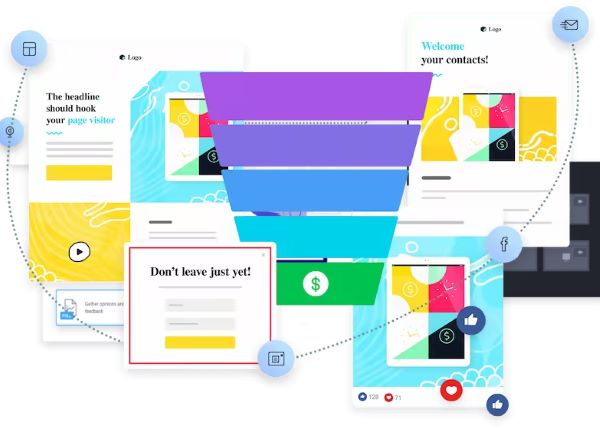

Split testing
Split testing involves sending variants of your e-newsletters to some of the people on your subscriber list, monitoring the performance of each, and sending the ‘best’ version to the remainder of your list.
GetResponse allows you to run split tests using up to five subject headers OR content variants.
However, you can only use one variable at a time during a split test — for example, you can test emails with different subject lines against each other, but both versions of the email must contain the same content (or vice versa).
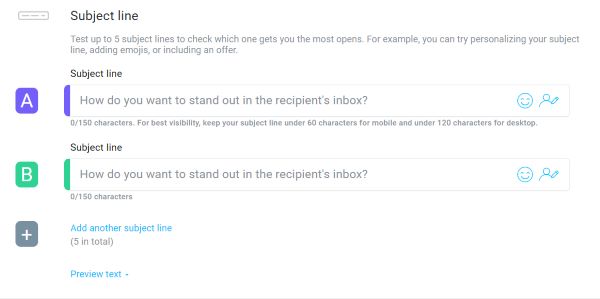
GetResponse Landing page creator
When it comes to lead generation, GetResponse offers something very useful that many of its competitors don’t: a landing page creator.
Using landing pages is usually a core part of any online advertising campaign (Facebook, Google Ads, etc.).
This is because online ads usually generate far more leads if, rather than simply directing people to an information-packed website, they point users to attractive ‘squeeze pages’ containing clear information and a clean, well-designed data capture form.

GetResponse lets you build sophisticated squeeze pages out of the box. Significantly, you can test the conversion rate of these pages against each other in real time and choose the best performing one for your ad campaigns.
This can have a very positive effect on the number of leads you capture and improve the reach of your email campaign.
Similar products often require you to make use of a third-party landing page creating tool to attain this sort of functionality, so the inclusion of the landing page feature is a really useful — and cost-saving — piece of functionality to have in your email marketing toolbox.
Crucially, GetResponse’s landing functionality is available on all plans — even the ‘GetResponse Free’ one. Given that leading landing page tools Unbounce and Instapage charge a minimum of $80 and $199 per month respectively, there are considerable savings to be made here.
The landing pages you create can be hooked up to a wide range of analytics tools and cookies, such as Google Analytics, Google Tag Manager, Kissmetrics and your Facebook pixel.
There are around 200 landing page templates to choose from — as with GetResponse’s email templates, these are professional and contemporary in appearance (particularly the more recently introduced ones).
There are a couple of problems with the landing page creator that need to be flagged up, however.
First, the interface is not particularly intuitive — in fact, it’s pretty clunky.
Second, you’ll usually need to create separate versions of your landing pages for desktop and mobile.
In some ways, this is a good thing, as it lets you hide bits of your landing page that you don’t want mobile users to see. But doing so involves a rather fiddly process.
Webinars
GetResponse recently introduced the ability to host webinars on the platform.
Webinars can be used as a lead-generation tactic — or indeed a revenue-generating feature — the idea of having your email database and your webinar tool under the same roof is very appealing.
The pricing is also very competitive too by comparison to established webinar solutions.
For example, one of the leading webinar hosting services, Gotowebinar, charges $59 per month to host webinars with up to 100 participants. You can actually do the same — and a whole lot more — with GetResponse from $49 per month.
With regard to attendee limits, the GetResponse ‘Plus’ plan allows you to host a webinar with up to 100 participants; the ‘Professional’ plan’s cap is 300; and the ‘Max’ plan’s cap is 1000.
GetResons surprisingly: both the webinar interface and functionality are really excellent — and are generally up there in terms of quality with any dedicated platform.

A few GetResponse webinar features worth flagging as being particularly useful are:
- the fact that your attendees don’t need to install any software to attend the webinars
- one-click record of your webinars
- screen sharing functionality
- video sharing functionality (YouTube)
- the option to upload PowerPoint presentations to GetResponse for use during a webinar.
The only downside really is that the file storage limits for your recorded webinars aren’t hugely generous — you get 3 hours of storage on the ‘Plus’ plan, 6 on ‘Pro’, and 20 on the ‘Max’ plan.
So, if your business is very much focused on webinar content, you may need to use a separate storage solution to share them with attendees.
But overall, the webinar functionality provided is a very useful feature to have in your email marketing arsenal and its inclusion as a feature gives GetResponse a very significant edge over its key competitors.
The fact that your email list is fully integrated with your webinar broadcasting tool is a serious plus point, and the quality of this feature is surprisingly high.
Let’s look at another feature now that is also pretty unique to GetResponse: “conversion funnels.”
Conversion funnels
Another new feature recently introduced by GetResponse is ‘conversion funnels’ — and this represents quite a departure for the product.
This is because — to a degree — it turns GetResponse from being an email marketing platform into something that you can use to run an entire e-commerce business.
The idea behind this feature is that you can do the following things without ever leaving the GetResponse environment:
- Create a product catalog
- Create and run Facebook ad campaigns
- Create landing pages
- Add subscribers to an autoresponder cycle
- Drive users to sales pages (also created in GetResponse)
- Take payment for products
- Send abandoned cart emails if necessary
You can access the conversion funnel feature on all plans — but you should note that the version available on the ‘Basic’ plan only allows you to create one sale funnel, and doesn’t permit you to make use of the abandoned cart recovery feature (this automatically emails people who added an item to their cart only to not complete their purchase).
If you like, you can involve third party platforms with this feature — for example, Shopify, BigCommerce, and Etsy can all be integrated.
As things stand, this feature is probably best suited for ‘solopreneurs’ or small businesses who want an all-in-one option for creating all the assets they need to produce a sales funnel.
Merchants with large product catalogs and extensive e-commerce requirements will still probably be better off using a dedicated e-commerce platform like BigCommerce or Shopify for the actual selling part of the mix.
GetResponse’s website builder
The latest addition to GetResponse’s feature set is a website builder.
This lets you create a website within the GetResponse interface and connect it to a domain you own (you can also if you like, buy your domain through GetResponse).
The templates for the website builder are pretty good, but as things stand the tool is a fairly basic affair, only letting you create simple, static pages.
You can add GetResponse forms very easily to these, which is helpful, but I couldn’t find an obvious way to add any products I had created in GetResponse to a test website that I put together with the builder.
So if you’re hoping to build an online store with this tool, you will be currently a bit disappointed. On the plus side, GetResponse says that full e-commerce functionality is on the way.
As a means for creating a simple brochure site though, it will work pretty well for some.
One key thing to note about GetResponse’s website builder is that the sites it creates aren’t terribly fast, or particularly compliant with Google’s new Core Web Vitals performance standards.
(This tends to be an issue for a lot of ‘hosted’ website building tools however even well-known platforms like Wix and Squarespace have problems in this area).
So overall, this new website builder feature is currently a bit underwhelming
but to be fair, it is in BETA, so you can expect improvements to it to be made. And the idea of having everything in one place — website, email marketing, webinars — is definitely an attractive one, particularly if you run a small business.
But as things stand, this feature needs a bit of work if it’s going to compete against more established websites and online store builders like Big Cartel, Squarespace or Wix.
GetResponse Chats
In the spirit of trying to be an ‘all-in-one’ marketing solution, GetResponse has now added a ‘chat’ feature that adds live chat functionality to your website (either one you’ve created via GetResponse’s new website builder feature or your existing site). This feature is available on the ‘Plus’ plan or higher.
To enable GetResponse Chats, you add a snippet of code to your site which then displays a live chat option to your visitors.
This is a pretty nifty little feature, which used correctly can help you increase conversion and subscription rates.
However, as with all features like this, there is a trade-off — adding more interactive tools like this to your site via scripts can have a negative impact on page loading times (which in turn can affect your site’s performance in search results).
But there are lots of contexts where this sort of functionality will come in very useful, so it’s definitely a nice addition to GetResponse’s feature set and one that will bring real value to users.
Ease of use/interface
On the whole, GetResponse is pretty user-friendly. This wasn’t always the case, but its interface was redesigned over the past couple of years and it is now easy to use, with key features easily accessible.
It’s certainly easy enough to do all the basics in GetResponse import contacts, create an email campaign, set up autoresponders, and check statistics. In particular, and as mentioned above, segment management is excellent.
And when it comes to GetResponse’s more advanced features, like its marketing automation tools, the learning curve isn’t too steep.
However, GetResponse’s form designer and landing page creator tools could still benefit from a bit of a further overhaul unlike most features of the product, they haven’t been improved much as part of the interface revamp. They could definitely be more user-friendly.
In terms of how the GetResponse interface stacks up against those of its competitors, I would argue that Campaign Monitor is a bit more user friendly, and that the Mailchimp interface features a cleaner design. AWeber’s interface probably comes closest in terms of look and feel.
Traditionally, GetResponse’s main usability failing involved its email editor: it was clunky and buggy.
However, the new version of the email creator has improved things considerably it’s got a cleaner, more intuitive drag and drop interface; it doesn’t crash; and it is easy to use. It’s probably not quite as good as those offered by some competing apps, but it’s perfectly acceptable.
Customer support
Up until very recently GetResponse customer support was amongst the most comprehensive available for email marketing tools — the company offered phone support alongside live chat support, email support, and various online tutorials and resources.
Sadly, the phone support has now been discontinued (unless you’re on the enterprise level “Max” plan). Instead, you’ll have to use live chat (24/7) or email support.
On the plus side, I have had extremely good experiences with GetResponse’s chat service — I’ve never had to wait long to chat with an agent, and anyone I’ve dealt with has had a really robust technical knowledge of the platform.
And the email support provided by GetResponse is available in 8 languages, which is commendable. These are English, Polish, German, French, Spanish, Italian, Russian, and Portuguese.
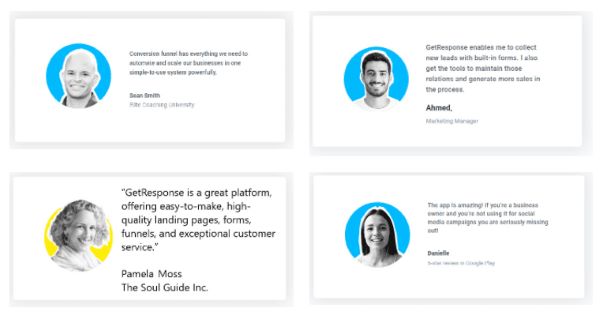
Pros and cons of GetResponse
Pros
- There’s a totally free version of the platform available, which can be used indefinitely.
- It’s pretty user friendly.
- So long as you are happy to use a ‘Basic’ plan, GetResponse is cheaper than many of its key competitors (in certain cases, significantly so) whilst offering just as much, if not more, functionality as them.
- The discounts you receive when paying upfront for one or two years of service are extremely generous — you’ll be hard pressed to find similar discounts from key competitors.
- It gives you extremely sophisticated tools for marketing automation.
- Its flexible approach to data segmentation makes list management really straightforward — it outshines many competing products on this front.
- GetResponse’s webinar functionality is great, and represents a genuine USP — I haven’t come across this functionality on similar products.
- The ‘Chats’ feature will prove to be a really useful addition to a lot of websites and used well can improve conversion rate significantly.
- All GetResponse plans come with a useful (if fiddly) landing page creator that facilitates A/B testing — something that could potentially save you a lot of money.
- Custom DKIM is provided on all plans.
- Support is provided in a wide variety of languages.
- With the notable exception of adequate cookie, and consent features on its landing pages, it’s pretty good at meeting GDPR requirements.
- The ‘all-in-one’ approach will appeal to small business owners on a budget — it saves them from having to invest in multiple tools.
- No credit card details are asked for when you sign up for the GetResponse trial.
Cons
- The drag and drop interfaces for creating landing pages and forms are a bit fiddly — they need improvement from a user experience point of view.
- Although you can use the Facebook pixel with GetResponse’s landing page feature, you can’t do so in a GDPR compliant way.
- Improvements could be made to how newsletter sign up forms work so that users have the option to switch them on or off on mobile devices.
- No phone support is provided (unless you’re on a “Max” plan).
- Split testing functionality is limited to subject lines and content — it would be good if you could test using sender and send time as well.
- Quite a lot of the integrations for GetResponse involve a third-party syncing tool like Zapier.
- The website builder needs improvement to truly compete with more established solutions.
GetResponse review conclusion
Overall, GetResponse represents one of the more cost-effective ways to host and communicate with an email database. It’s priced competitively in its marketplace, and is also one of the more interesting products of its kind, in that it provides email marketing, automation, landing pages, e-commerce, sales funnels, live chat, and webinars all in one place.
It’s hard to think of any competing email marketing solution that offers this ‘all round’ proposition; this makes it a particularly good fit for new business owners without a budget to invest in multiple tools. Its ‘Free-forever’ plan is very generous too.
I’ve been particularly impressed by the GetResponse webinar functionality it’s feature packed, and amazingly good value for what it is.
Some improvements to GetResponse do need to be made, however.
Probably the most important thing GetResponse needs to look at is introducing a GDPR-compliant cookie consent mechanism for the landing pages.
The landing page interface could do with an overhaul too it could be more user friendly.
I’d also like to see more controls for GetResponse’s data capture forms introduced you should have the option to switch them on or off on mobile.



